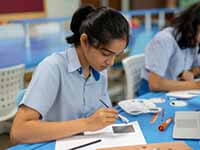For years, educational experts focused on knowledge acquisition within the classroom, and school libraries played a fundamental role in the process of learning and retaining new information. However, in the 21st century, learning is about more than just knowledge acquisition — it’s also about developing skills and building competencies, such as collaboration, critical thinking, communication and creativity.
Given this shift in the education approach, it is no surprise that learning spaces have had to adapt. Today, learning spaces in modern smart schools include not only a school library but also common spaces and labs designed to encourage innovation and collaboration. Of course, the school library functions as a space for learning, reading and growing, but it’s also an area where students can collaborate with their peers and interact with technology.
What does a 21st-Century school library look like?
When you think of a school library, your mind likely conjures up images of wooden bookshelves, stacks of academic books and tables that are perfect for studying. However, in smart schools, libraries also function as innovative learning spaces.
A 21st-century school library is a technology-led learning space that provides students with the tools they require to develop the skills they need in the future. Within the library, students have access to a wide range of both books and online tools, such as educational apps, to research, explore and find the answers they are searching for.
In addition, these libraries feature smart kiosks that make it easy for students to borrow and return books. This makes the school library a more convenient and accessible place for all students and allows everyone to get the materials they need at their convenience.
They may come with smart screens, displaying documentaries or other fact-based media to enhance student engagement. These screens provide students with an alternative way of acquiring knowledge and give them a chance to gain information in a way that feels comfortable.
Of course, the school library will always have cosy and quiet corners where students can read or study. But in a 21st-century school library, there are also collaborative spaces where students can connect and communicate with each other and work together towards a common goal. By creating these spaces in the learning environment, students can naturally develop the 21st-century competencies they will need in the future.

The libraries at GIIS
At GIIS, we are proud to have learning spaces that are designed to enhance student learning outcomes. In addition to these learning spaces, such as our school libraries, we also have Learning Commons — these are spaces that allow students to think, collaborate and act. They merge the physical and digital world, thereby providing the best of both worlds, and the learning opportunity.
Our GIIS SMART Campus features two school libraries, one for our primary students and another for our secondary students. Combined, the primary and secondary libraries have more than 20,000 physical books as well as multiple educational tools across topics and genres. These digital tools such as access to ebooks and current technology have transformed conventional learning to a custom-based learning environment .
Students enjoy both teacher-led and student-led sessions at the libraries, where they have access to smart screens, iPad kiosks, borrowing machines and drop boxes. In addition, the libraries feature quiet spaces for individual reading along with group activity corners where students can discuss new topics and ideas with one another. The smart library fosters an environment for knowledge co-construction.
Also read: 5 key aspects of a robust learning environment
Primary school library
The primary school library is a space where our primary students can explore their favourite topics and learn new information. Students have access to more than 7,000 books across all genres, and they can also use platforms such as Epic and SORA to borrow ebooks and audiobooks.
In the primary library, students enjoy activities such as:
● Group reading sessions. During these sessions, students read independently or enjoy a read-aloud with a teacher.
● Adopt-a-shelf programmes. Different grades are given particular shelves in the library and are expected to arrange and maintain them.
● Collaborative lessons on digital citizenship and academic honesty. Students learn about online safety, reliable websites and effective online resources and often work on iPads during these sessions.
Secondary school library
The secondary school library quickly becomes a favourite spot for secondary students, who can rely on this space to complete their research, work through their assignments and collaborate with their peers. In this library, students will find 15,391 books — an astounding number that continues to wow and amaze most students.
In addition, they have access to at least 20 digital ebook platforms, such as InThinking, JSTOR, etc. The library also boasts many innovative technology features, including three self-borrowing machines, an iPad kiosk with 12 iPads and a drop box.
Some of the many activities that secondary students enjoy in this school library include:
● Utilising the iPads on the kiosk to gather information or complete their school assignments.
● Working together in groups on the collaborative projects they have been assigned.
The school libraries at GIIS are safe spaces where students can delve into books, literature, articles and more — knowing that they are absorbing genuine, factual and authentic information. In an age where the prevalence of fake information threatens to undo the fabric of society, it is more important than ever for students to have learning spaces where they can explore new ideas that are rooted in facts.
At GIIS, we are committed to transforming all our students into global citizens who are supported by knowledge and skills. In this way, our students are uniquely prepared to take on the future. Our teachers and students do not simply use the library for access to information but also as a learning common to encourage participatory learning. The interaction of students with content, technology space and each other helps not only to enhance but also apply knowledge.
For more information about our school library and all our innovative learning spaces, please don’t hesitate to book a campus tour today.

































